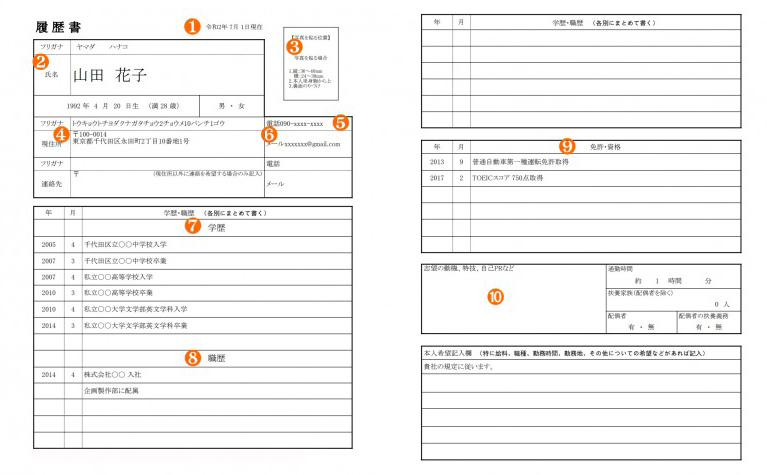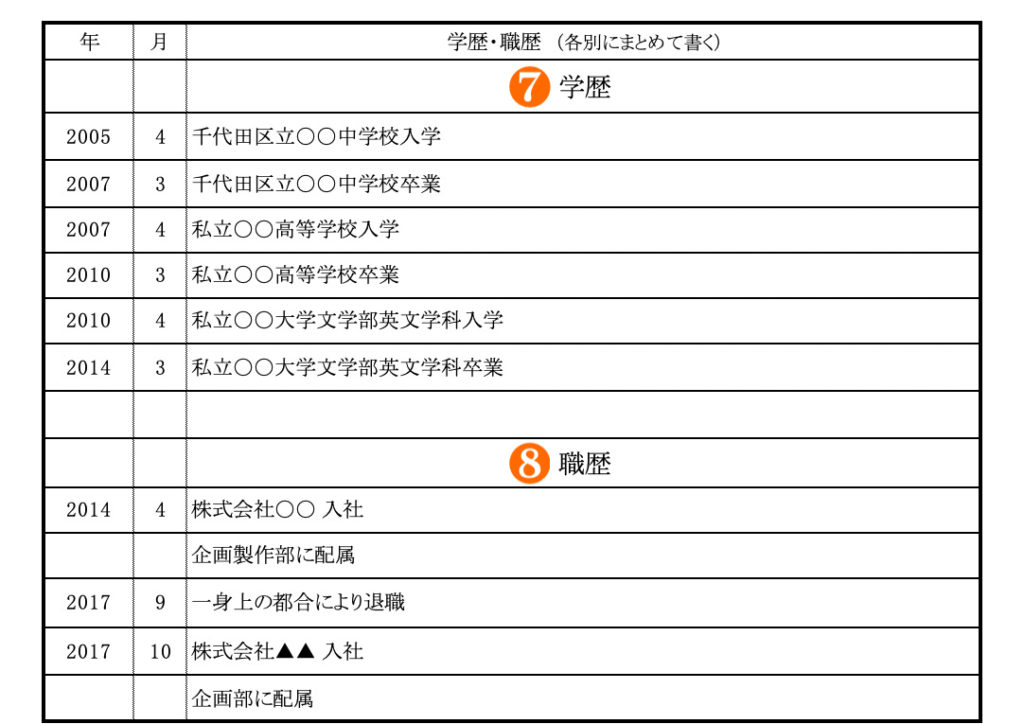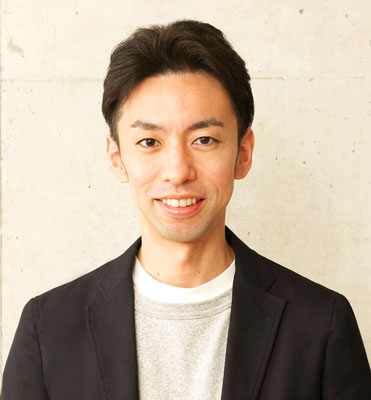The first step to finding a job in Japan is sending out your resume. It’s an incredibly important document that will form your first impression to a potential employer and can make or break your chances of getting through the screening process and on to the interview round. That’s why in this article, we’ll introduce tips on writing the kind of resume that catches a recruiter’s eyes! Be sure to not miss the advice from a CEO with years of experience in hiring foreign staff at the end of the article!
What You’ll Need to Write a Japanese Resume

1. Electronic or Paper Resume
In the past, writing a resume by hand was the norm, but nowadays, composing one on a computer and submitting it electronically is commonplace. Some companies may still prefer a handwritten document while others favor a digital one, so please tailor your resume to the company that you’re applying for.
If you’ll be writing your resume on a computer, download a proper template off the internet. In case a company requests a physical copy of the typed resume, make sure to print it out on high-quality or resume-grade paper.
If you’ll be writing your resume by hand, you can get the paper you’ll need at most stationery stores, convenience stores, or supermarkets. The papers come in both B5 and A4 sizes, but most companies typically work with A4 documents, so that is the size that we recommend. Some companies will also require candidates to use a specific format when filling out their resume, so make sure you read the application instructions carefully.
You can download computer resume templates directly from our site:
2. Proper Writing Implements
If you’ll be writing your resume by hand, use a black ballpoint pen or fountain pen. Do not use whiteout or correction tape. If you make a mistake, start over from the beginning.
3. Photograph
Most Japanese companies require applicants to include a photo of themselves on their resumes. While it’s best to have your resume picture taken at a professional photo studio, it is also possible to take your own at special photo booths found in train stations or shopping complexes. Make sure to wear a suit for the picture.
The Correct Way to Write a Japanese Resume
If you’re writing your resume by hand, please make your handwriting as neat and tidy as possible. Use honorific Japanese forms like desu or –masu and Arabic numerals (1, 2, 3) throughout the document.
We’ll now explain the correct way of filling out each section of a typical resume:

1. Date
Do not write down the day that you wrote the resume. Instead, write down the date that you’ll be submitting the resume, bringing it to an interview, or putting it in the mail.
2. Full Name
Write your name in the Japanese order, with your last name first, followed by your first and middle name (if you have one). Leave a small space between each name. Your name is one of the first things that a recruiter will see, so try to write it as neatly as possible. If the “furigana” section above your name is written in hiragana (ふりがな), write the Japanese reading of your name in hiragana. If it’s written in katakana (フリガナ), use katakana.
3. Photograph
Recruiters pay special attention to faces, so make sure you attach a bright and neat photo to the resume. If possible, a picture taken at a photo studio is recommended over one from a photo booth. Be sure you make yourself look presentable and give a nice smile so that you don’t appear too tense.
Photographs on Japanese resumes should be taken within the last 3 months. Also, in case the photograph accidentally falls off the document, write your name on the back so that it can be identified.
Note that many Japanese employers will still require a photograph even if you’re submitting an electronic resume, so make sure to acquire both physical and electronic copies of your photograph. Many photo booths allow you to download an electronic copy of the photos you take.
4. Address / Contact Information
Write down the address where you’re living right now, including the prefecture, the name of your building, and the number of your apartment, without abbreviating anything. When writing down the street address, do not use the hyphen-separated (1-2-3) format. Instead, use the traditional “1丁目2番地3号” format. Fill out the “Contact Information” (連絡先) section only if it’s different from your address.
5. Telephone Number
Write down a number where you can always be reached. If you have a landline and a cellphone, write down both numbers.
6. Email Address
Write down an address where you can always be reached. Pay special attention to this section, especially when writing down characters that can be easily mistaken for one another, like the letter “o” and the number “0.”

7. Education
When filling out the Education/Professional Experience section, start with your education. First, write the kanji for “Academic Background” (学歴) in the middle of the first line, then list the schools you attended in chronological order below. It’s typical to start from junior high school. For each school, list the year and month that you began attending, the name of the school, and the kanji “入学” (entered school) on one line, followed on the next line by the year and month that you graduated, the name of the school again, and the kanji “卒業” (graduation). In the case that you couldn’t graduate for some reason, instead of “卒業,” write the kanji “中途退学” (left during a school term) followed by a short explanation on the next line.
If the name of your school is in English, it’s okay to translate general words like “middle school” or “university” into Japanese, but it’s also fine not to translate the name at all. For example, you could write “Harvard University” or “Harvard大学.” Either way is fine. However, do not abbreviate the schools’ names, and when listing your vocational school/university, be sure to specify your department, course of study, and major.
8. Professional Experience
Leave one line empty under the last entry in the education section, write “Professional Experience” (職歴) in the middle of the line below, and then list your work experience in chronological order below that. For each company, write the year and month that you joined the company, the full name of the company, and the kanji “入社” (entered company). If the company is from overseas, write the official name in English. On the next line, write the name of the department that you started working in, followed by “に配属” (assigned to).
If your department or position changed during your time at a company, write each change or promotion on a new line (eg. “営業部へ移動” (moved to sales department) or “マネージャに昇格” (promoted to manager)). Also, write the year and month that you left a company followed by a simple reason and the kanji “退職” (resigned). It’s usually not necessary to give a detailed reason for leaving a company, and the sentence “一身上の都合により退職” (resigned for personal reasons) is very commonly used.
9. Licenses & Certifications
Write down the full names of your licenses and certifications and the dates when you obtained them. Language certifications like the Japanese-Language Proficiency Test as well as other certifications that are relevant to the field that you’re applying to are a great way to build up your profile, so make sure you don’t forget about this section.
10. Personal Statement
Use this section to succinctly explain your reasons for applying for the job and what you hope to get out of it. Make sure to mention why the position interests you, what skills and experiences you can bring to the table, and other ways that you can benefit the company.
Some resumes have separate columns for Personal Statements (本人希望) and Reasons for Applying (志望動機). In such a case, unless specified otherwise, simply write “貴社の規定に従います” (”I’ll obey all the company rules”) in the Personal Statement section and fill out the Reasons for Applying section as usual.
Advice From a CEO With Many Foreign Employees: “When Hiring Foreigners, Companies Pay Attention to These Parts of the Resume!”
Ryo Hagiwara is the CEO of D2C X, which manages tsunagu Japan (the largest tourism media company in Japan) and tsunagu Local (a site geared towards expats). In charge of a diverse, multicultural team, he is an expert when it comes to hiring foreign staff. We asked CEO Hagiwara which parts of the resume people pay attention to when hiring foreigners, and this is what he shared.

These are the three points to focus on when writing a Japanese resume that will make employers want to meet you in person!
1. Be specific about which of your skills and experiences will be best suited for the job you’re applying to!
A potential employer wants to know how you’ll benefit the company. It’s important for your resume to make those kinds of things clear. Use the “Reasons for Applying” or “Self Introduction” (自己PR) segments to talk about your skills, experiences, and strengths, and explain how you will be able to put them to use at that company. Make it simple and make it appealing by using specific examples to illustrate those things. It will work to your advantage.
2. Make sure the employer knows you have some Japanese language skills and knowledge of Japanese corporate culture!
An employer needs to know that a potential employee understands the Japanese corporate culture and knows enough Japanese to properly do their job. They do that by looking for errors in the resume: wrong characters, missing characters, grammatical errors, etc.
- Note: Some companies or positions accept resumes in languages other than Japanese.
3. Highlight your personality, sincerity, and motivation!
Besides skills and experiences, employers also pay attention to the person themselves. Will their personality be a good fit? Do they seem motivated? It’s hard to glimpse those things from a resume, so use the “Reasons for Applying” or “Self Introduction” segments to emphasize your best qualities.
A Message From CEO Hagiwara
The hiring process consists of resume screening followed by interviews. If you don’t make it through the former, you won’t get to the latter.
During the screening process, employers pay attention to the above mentioned three points regardless of whether the candidate is Japanese or foreign. However, foreign employees in particular will be scrutinized to make sure that they have at least the minimum Japanese language skills and knowledge of Japan’s corporate culture needed to succeed. At our company, we also accept English resumes, but many companies only deal with Japanese ones. They don’t need to be perfect, but if an employer sees that you’re trying your best in a language that’s foreign to you, that will go a long way to showing off your character and motivation.
You also need to explain clearly and specifically how your skills and experiences will fit into the job that you’re applying to. When someone does a good job at showing this, it makes me think, “Ah, yes, this person knows what they’re doing.”
Even if they don’t have all the necessary skills or experience, a well-written resume that emphasizes a candidate’s best qualities can still make me see their potential and think, “I want to work with this person” or “This person would really benefit our company.”
As CEO Hagiwara said, companies search resumes for indications that a person “will benefit the company” or “seems like someone we would want on our team,” etc. You don’t have a lot of room to work with on a resume, so it is essential to use the space efficiently to clearly and specifically state your strengths and best qualities. This is the best way to make it past the screening process and on to the interview round. So, don’t forget to build yourself up while following the basic guidelines of Japanese resume writing!
If you want to give feedback on any of our articles, you have an idea that you’d really like to see come to life, or you just have a question on Japan, hit us up on our Facebook!
The information in this article is accurate at the time of publication.

